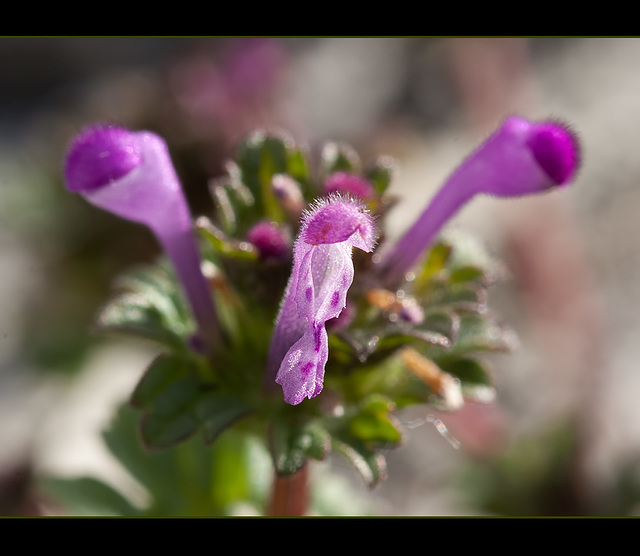"And We're Flying...And We're Flying...And We're F…
71/365: "Oh, What A Beautiful Morning, Oh What A B…
Charred Bark from a Controlled Burn
Sporophytes Growing From Ash-Loving Moss (2 more p…
[STORYTIME!]72/365: “He was a killer, a thing that…
Chickweed Monkeyflower Blossom
Chickweed Monkeyflower Covered in Dew (4 pictures…
73/365: "Delight in the beauty that surrounds you.…
Orb Weaver Next to the Rogue River
Male Pussy Willow Catkins
74/365: "Nothing is more important than reconnecti…
Cowbag Clover Blossom (1 picture below)
Pair of Grass Widow Blossoms (4 pictures below!)
Hawk in Flight
Mardi Gras Seed Pod, AKA Sand Fringepod
75/365: "Flowers are a proud assertion that a ray…
Beautiful Rose Maid
Tiny Dandilion Blossom
Glowing Blossom
76/365: "Cycle tracks will abound in Utopia." ~ H.…
Dreamy Textured Grass with Double Droplet
Henderson's Shooting Stars (6 more pix below!)
77/365: "Beauty is but a flower, which wrinkles wi…
Deadnettle Bud
70/365: "We may get to the point where the only wa…
American Robin Singing to the Morning Sun
Glowing Ferns Unfurling in a Ray of Afternoon Suns…
69/365: "A closed mouth catches no flies." ~ Migue…
Perfect Buttercup
The 159th Flower of Spring & Summer: Sparkling Blo…
Darling Little Sandwort
68/365: "Green is the prime color of the world, an…
Resin Droplet Caught in Web!!
Double Resin Droplets
67/365: “It’s a thorny road for dreamers and poets…
Frosted Thorns
Glowing Leaves (1 pic below)
66/365: "The buttercups, bright-eyed and bold, Hel…
Frosted Buttercup Bud
Totally Groovy Saxifrage!
Holy Sparkling Frosty Droplets, Batman!
65/365: "Think twice before you speak, because you…
Textured Crocus, Dedicated to Kat & Stephanie
Spring Whitlow Grass Seed Pod (1 picture below)
64/365: "Life is like a camera; focus on what's im…
See also...
Keywords
Authorizations, license
-
Visible by: Everyone -
All rights reserved
-
290 visits
The 160th Flower of Spring & Summer: Henbit Deadnettle (2 pictures below)


Woo hoo, this is one tiny little flower!! I was trying to get pictures of these in bud form and kept failing. I also didn't realize at the time that the fuzzy buds weren't a strange little flower because I kept seeing them dead and fallen out. Now I understand that the morning frost was killing the buds, and that's why they weren't developing into flowers. Today I checked them and suddenly everything became clear to me! I discovered that one was in full bloom, with many close behind, and my original suspicion proved to be correct: this was a kind of Deadnettle I'd never seen before! It's much smaller than the Purple Deadnettle featured last spring as #40 in my flower count, but its flowers are unmistakable! (Please scroll down to see a close up of one of the opening buds, isn't it lovely and strange looking?! It's like a slipper! I also included a picture of the Purple Deadnettle flower to compare.
From Wikipedia: Henbit Deadnettle is a species of Lamium native to Europe, western Asia and northern Africa. It is a low-growing annual plant growing to 10-25 cm tall, with soft, finely hairy stems. The leaves are opposite, rounded, 2-3 cm diameter, with a lobed margin. The flowers are pink to purple, 1.5-2 cm long. It flowers very early in the spring even in northern areas, and for most of the winter and the early spring in warmer areas such as the Mediterranean region. It propagates freely by seed and is regarded as a minor weed. Sometimes entire fields will be reddish-purple with its flowers before spring plowing. Where common, is an important nectar and pollen plant for bees, especially honeybees, where it helps start the spring buildup. It is widely naturalised in eastern North America and elsewhere, where it is often considered to be an invasive weed. However, its edibility and readiness to grow in many climes often mean it is permitted to grow when other 'weeds' are not. The leaves, stem, and flowers of the plant are edible and are faintly reminiscent of spinach. The specific name refers to the amplexicaul leaves (leaves grasping the stem).
From Wikipedia: Henbit Deadnettle is a species of Lamium native to Europe, western Asia and northern Africa. It is a low-growing annual plant growing to 10-25 cm tall, with soft, finely hairy stems. The leaves are opposite, rounded, 2-3 cm diameter, with a lobed margin. The flowers are pink to purple, 1.5-2 cm long. It flowers very early in the spring even in northern areas, and for most of the winter and the early spring in warmer areas such as the Mediterranean region. It propagates freely by seed and is regarded as a minor weed. Sometimes entire fields will be reddish-purple with its flowers before spring plowing. Where common, is an important nectar and pollen plant for bees, especially honeybees, where it helps start the spring buildup. It is widely naturalised in eastern North America and elsewhere, where it is often considered to be an invasive weed. However, its edibility and readiness to grow in many climes often mean it is permitted to grow when other 'weeds' are not. The leaves, stem, and flowers of the plant are edible and are faintly reminiscent of spinach. The specific name refers to the amplexicaul leaves (leaves grasping the stem).
- Keyboard shortcuts:
Jump to top
RSS feed- Latest comments - Subscribe to the comment feeds of this photo
- ipernity © 2007-2024
- Help & Contact
|
Club news
|
About ipernity
|
History |
ipernity Club & Prices |
Guide of good conduct
Donate | Group guidelines | Privacy policy | Terms of use | Statutes | In memoria -
Facebook
Twitter

Sign-in to write a comment.